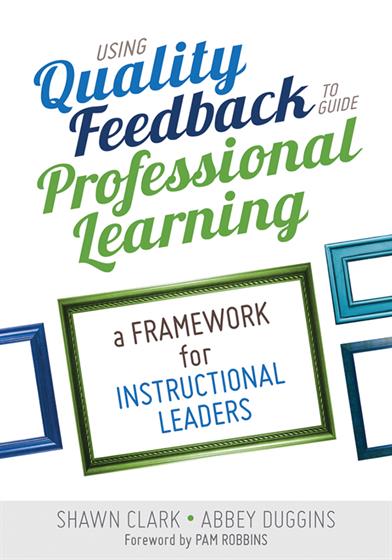List of Figures
Foreword by Pam Robbins
Preface
Acknowledgments
About the Authors
Chapter 1: Why Use Quality Feedback to Guide Professional Learning?
Our Journey Toward Quality Feedback
Administrator’s Turn
Coach’s Turn
Measurable Results: Impact Data
A Note About Culture
Defining Quality Feedback
Immediate Implementation of Quality Feedback
From Words to Action
Chapter 2: What Research Guides Our Beliefs About Professional Learning?
Beliefs About Professional Learning
Teachers as Professionals: Honoring Teacher Voice by Tailoring Professional Learning
Administrator’s Turn
Coach’s Turn
Learning as a Social Process
Quality Feedback as a Tool for Reflection
Providing Feedback in One-on-One Professional Learning Settings
Coach’s Turn
From Words to Action
Chapter 3: How Can Quality Feedback Be Used to Guide Professional Learning?
Research and Related Studies on Quality Feedback
Using Feedback to Grow Your Teachers Versus Weeding Them Out
Administrator’s Turn
Teacher’s Turn
Coach’s Turn
Additional Notes Regarding Our Experience With Providing Quality Feedback
From Words to Action
Chapter 4: How Can Quality Feedback Support the Novice Teacher?
Research and Rationale for Creating Strong Induction Programs
Sample Professional Learning Opportunities to Provide Feedback to Novice Teachers
Administrator’s Turn
Coach’s Turn
Teacher’s Turn
From Words to Action
Chapter 5: How Can Quality Feedback Guide the Good Teacher to Greatness?
Lessons from Good to Great
Sample Professional Learning Opportunities That Empower Teachers
Coach’s Turn
Pushing the Envelope and Achieving Consistent Excellence
Administrator’s Turn
Teacher’s Turn
From Words to Action
Chapter 6: How Can Quality Feedback Support the Struggling Teacher?
Sample Professional Learning Opportunities to Support Struggling Teachers
Administrator’s Turn
Teacher’s Turn
Coach’s Turn
From Words to Action
Chapter 7: How Can Instructional Leaders Provide Quality Feedback on Assessments?
Build an Assessment-Literate Culture
Teacher’s Turn
Sample Professional Learning Opportunities to Support Teachers
Teacher’s Turn
System of Assessment Validation
Administrator’s Turn
Coach’s Turn
From Words to Action
Chapter 8: How Can Instructional Leaders Provide Quality Feedback by Observing?
Making Observations a Priority
Administrator’s Turn
Observation Techniques
Sample Professional Learning Opportunities to Support Teachers
Coach’s Turn
Teacher’s Turn
From Words to Action
Chapter 9: How Can Instructional Leaders Provide Quality Feedback Through the Use of Video?
How It All Began: A Little Bit of Context
Rationale for Using Video
Sample Professional Learning Opportunities to Support Teachers
Teacher’s Turn
Administrator’s Turn
Coach’s Turn
Expanding the Use of Video
Teacher's Turn
From Words to Action
Epilogue
Appendix A. Characteristics of Quality Feedback (Figure 1.2)
Appendix B. Quality of Feedback: Supporting Administrator Feedback to Teachers Throughout the Year
Appendix C
C1. Tool 2 QPA Sorting Kindergarten
C2. QPA Plan Sorting Kindergarten
C3. QPA Sorting Assessment Kindergarten
Appendix D
D1. Tool 2 Assessment Validation Newspaper Project English III
D2. Newspaper Project English III Assessment With Feedback
Appendix E
E1. Tool 2 Assessment Validation World Religions
E2. World Religions Assessment With Feedback
Recommended Readings
References
Index





